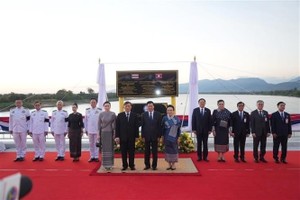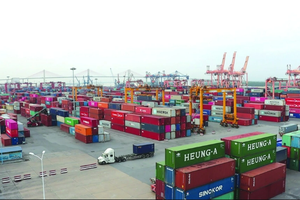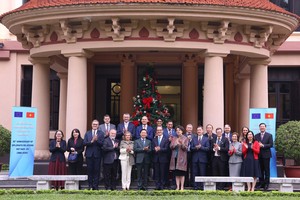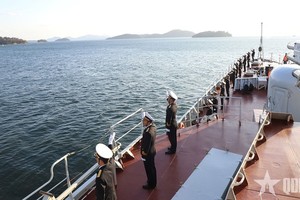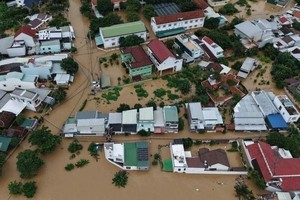SENDAI, Japan, March 26, 2011 (AFP) - Radiation levels have surged in seawater near a tsunami-stricken nuclear power station in Japan, officials said Saturday, as engineers battled to stabilise the plant in hazardous conditions.
Urgent efforts were under way to drain pools of highly radioactive water near the reactors, after several workers sustained radiation burns while installing cables as part of efforts to restore the critical cooling systems.
The new safety worries further complicated efforts to bring the ageing facility under control, and raised fears that the fuel rod vessels or their valves and pipes are leaking.
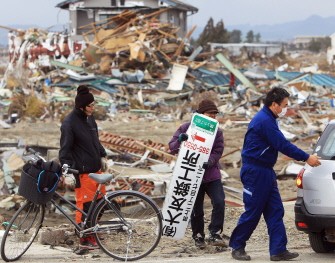
"It is becoming very important to get rid of the puddles quickly," said an official at the nuclear safety agency, Hidehiko Nishiyama.
One of the worst-case scenarios at reactor three would be that the fuel inside the reactor core -- a volatile uranium-plutonium mix -- has already started to burn its way through its steel pressure vessel.
Fire engines have hosed thousands of tons of seawater onto the plant in a bid to keep the fuel rods inside reactor cores and pools from being exposed to the air, where they could reach critical stage and go into full meltdown.
Several hundred metres offshore in the Pacific Ocean, levels of iodine-131 some 1,250 times the legal limit were detected Saturday, a ten-fold increase from just days earlier, operator Tokyo Electric Power Co. (TEPCO) said.
Drinking a half-litre (20-ounce) bottle of fresh water with the same concentration would expose a person to their annual safe dose, Nishiyama said, but he ruled out an immediate threat to aquatic life and seafood safety.
"Generally speaking, radioactive material released into the sea will spread due to tides, so you need much more for seaweed and sea life to absorb it," he said.
Because iodine-131 decays relatively quickly with a half-life of eight days, "by the time people eat the sea products, its amount is likely to have diminished significantly," he said.
However, TEPCO also reported levels of caesium-137 -- which has a longer half life of about 30 years -- almost 80 times the legal maximum. Scientists say both radioactive substances can cause cancer if absorbed by humans.
The government's assurances did little to lift the gloom that has hung over Japan since a 9.0-magnitude quake struck on March 11 and sent a huge tsunami crashing into the northeast coast in the country's worst post-war disaster.
The wave easily overwhelmed the world's biggest sea defences and swallowed entire communities. The confirmed death toll rose to 10,151 on Saturday, with little hope seen for most of the 17,053 listed as missing.
The tsunami knocked out the cooling systems for the six reactors of the Fukushima plant, leading to suspected partial meltdowns in three of them. Hydrogen explosions and fires that have also ripped through the facility.
High-voltage electric cables have since been linked up to the reactors again and power has been partially restored in two reactor control rooms.
Worried about the salt buildup in the crippled plant, engineers have started pumping in fresh water into some of the reactors. The US military is supporting the effort by sending two full water barges from a naval base near Tokyo.
"I believe we have prevented the current situation worsening, taking steps towards real progress such as resuming power and injecting water," chief government spokesman Yukio Edano told reporters.
Radioactive vapour from the plant has contaminated farm produce and dairy products in the region, leading to shipment halts in Japan as well as the United States, European Union, China and a host of other nations.
Higher than normal radiation has also been detected in tap water in and around Tokyo, some 250 kilometres (155 miles) from the plant, leading authorities at one stage to warn against using it for baby milk formula.
Japan widened the zone around the plant where it suggests people evacuate, to 30 kilometres (20 miles) -- still below the 80 kilometres advised by the United States, and larger areas including Tokyo in other nations' alerts.
Environmental watchdog Greenpeace started its own monitoring near the plant, charging that "authorities have consistently appeared to underestimate both the risks and extent of radioactive contamination".
"We have come to Fukushima to bear witness to the impacts of this crisis and to provide some independent insight into the resulting radioactive contamination," said the group's radioactivity safety adviser Jan van de Putte.
The campaign group said it would provide "an alternative to the often contradictory information released by nuclear regulators".
